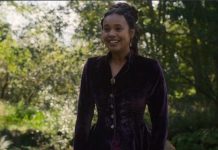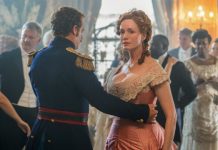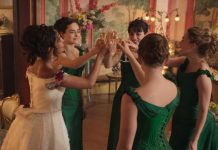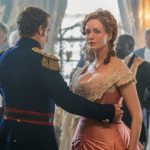One treasure among the Apple TV adaptations that has drawn in both fans and book aficionados is “The Buccaneers.” The daughters of America’s nouveau riche, the Buccaneers, are beautiful and wild despite the best efforts of England’s greatest governesses, and they’re on their way to London to marry into the aristocracy. “The Buccaneers” for Apple TV transports viewers to the Gilded Age through visual storytelling while fusing historical detail with a modern sensibility. This engrossing series explores the fascinating universe that a renowned American author imagined. tvacute begins this investigation by dissecting an unfinished book and learning how Apple TV has brought it to life.
The Buccaneers Season 1 Episode 3 Recap: Ending Explained!
The Buccaneers on Apple TV
Directed by Susanna White, the eight-episode series “The Buccaneers” is set against a backdrop of social unrest and increasing wealth. Annabelle “Nan” St. George, the main character, represents the wealth created by the stock market in America. Nan’s trip takes an unexpected turn when her mother enlists the help of Laura Testvalley, a British governess, in the midst of obstacles in New York’s high society. The work, which was unfinished when Wharton passed away, tells the story of courtships, weddings, and cross-cultural conflicts set against the background of England’s nobility. A miniseries adaptation of this story was originally produced in 1995 for BBC Television.
The show, which was developed by Katharine Jakeways and is led by an all-female creative team, aims to combine historical authenticity with a modern aesthetic. The teaser teases a time-traveling viewpoint from the American protagonists, giving Wharton’s classic story a new lease on life.
As Kristine Froseth assumes Nan’s role, she negotiates the challenges presented by cultural norms. Nan’s mother, played by Christina Hendricks, is enmeshed in a marriage that heightens the suspense as the story develops. Josie Totah, Aubri Ibrag, and Alisha Boe play the intrepid buccaneers, while Imogen Waterhouse plays Nan’s older sister, Virginia St. George.
Is [Apple TV] The Buccaneers based on the Unfinished Novel?
Yes, [Apple TV]’s “The Buccaneers” is indeed based on Edith Wharton‘s unfinished novel of the same name. Despite being abandoned, “The Buccaneers” novel offers a solid basis for the television adaptation. Wharton’s writings serve as the inspiration for the plot, characters, and thematic topics that are covered in the series. Wharton’s legacy is carried on by this adaptation, which gives viewers a visual representation of the story she started but was unable to finish.
It becomes clear that artistic license was employed in order to maximize the story’s emotional and visual effect as we watch the adaptation play out on film. With every shot brimming with the wealth and social nuances that Wharton so deftly incorporated into her stories, the characters come to life. This version gives Wharton’s beloved story new life by reimagining it for a modern audience rather than just recounting it.
An Issue with Unfinished Stories
There are difficulties involved with adapting an incomplete work, and “The Buccaneers” is no exception. Marion Mainwaring’s 1993 novel’s finale, which was first released with a thorough synopsis outlining its resolution, was met with conflicting reviews. Academics and fans got into heated discussions on whether the conclusion remained true to Wharton’s unique style, highlighting the difficulties in finishing the work of a literary titan.
Through incorporating the inventiveness of television into Wharton’s writing, [Apple TV] aims to offer audiences an engrossing adaptation of “The Buccaneers.” With this adaptation, viewers can interact with Wharton’s writing in a fresh way and introduce a new generation of viewers to the core of her storytelling.
Viewers are spared the frustration of an unsolved plot in this reinterpretation. Rather, the series delivers a resolution, bringing a feeling of completion to a story that Wharton was unable to complete herself for reasons we will discuss. It’s a tasteful fusion of acknowledging the author with the needs of a visual medium.
Why Is Edith Wharton’s Novel Not Completed?
Because of her passing in 1937, Edith Wharton’s last book, “The Buccaneers,” is still unfinished. She left a tempting legacy of incomplete work at the time of her death. The “The Buccaneers” manuscript was roughly 89,000 words long, or roughly three-fifths of the original work. It was an outline. These words, however, did not complete an Edith Wharton novel.
The fact that Wharton wrote the novel so methodically contributed much to its fragmentary state. Her method placed a strong emphasis on attention to detail; scenes would often be rewritten until they satisfied her strict requirements. Although “The Buccaneers” had fairly completed early chapters, later sections were less detailed, and at the end only the essential plot points were revealed. Even in its unfinished state, this imperfect shape offered readers a glimpse of the author’s talent when it was published posthumously.
The premise of “The Buccaneers” revolved around the American heiresses’ assimilation of the strapped European nobility in the late 1800s. This social phenomenon offered a complicated web of ramifications, accommodations, and broken and realized hopes, and it also captivated Wharton’s buddy Henry James. Living on both sides of the Atlantic, Wharton was in a rare position to observe and analyze this transatlantic drama.
Edith Wharton’s Life and Career
The life of Edith Wharton is a work of fiction in and of itself, full of romance, multi-continental travel, and intricate layers of intricacy. She was raised in a privileged and well-known household and was born Edith Newbold Jones on January 24, 1862. She had to navigate a world of privilege and expectations. The phrase “keeping up with the Joneses” is thought to have originated from her paternal family, the Joneses, who were known for their wealth.
Her early years were characterized by lengthy trips throughout Europe, where she became fluent in Italian, German, and French. Naturally rebellious, Edith disapproved of the shallow expectations placed on young girls in her era. She disobeyed her mother’s ban on novels till marriage by reading a lot of books from her father’s library since she had an insatiable need for knowledge.
Early Years of Writing
The career of Edith Wharton as a writer started at a young age. When her family relocated to Europe, she began “making up” stories, demonstrating her natural talent for storytelling. She briefly turned to poetry after receiving early criticism from her mother, but at the age of 15, she published her first piece, a translation that brought in $50.
Wharton briefly put her work on hold between 1880 and 1890 in order to partake in the social customs of the upper classes in New York. During this time, she made astute observations that served as the basis for her subsequent social criticism in pieces like “The Age of Innocence“ and “The House of Mirth.” Wharton’s keen observation of social subtleties persisted over the break, which enhanced the depth of her subsequent writings.
The Later Years of Wharton
The Mount, Edith Wharton’s mansion near Lenox, Massachusetts, was created in 1902 and served as her principal home until 1911. Some of her most well-known works, such as “The House of Mirth,” were born in this creative sanctuary. Wharton strengthened her standing in American literary society by hosting notable authors like Henry James.
Wharton became an unwavering supporter of the French war effort when World War I broke out. Notwithstanding her personal struggles, which included her husband’s divorce in 1913, Wharton committed her life to philanthropic work. She assisted Belgian refugees, set up workrooms for jobless women, and was named a Chevalier of the Legion d’Honour by the French President.
Edith Wharton’s life and writings are still relevant today; adaptations of her stories, such as “The Buccaneers” on Apple TV, attest to their ageless appeal. Whether you’ve read Wharton’s books before or are diving into this historical drama for the first time, “The Buccaneers” promises to be an engrossing journey over the choppy waters of Gilded Age mystery. We come across a literary trailblazer whose influence goes well beyond the pages of her novels as we work our way through the complexities of her tales and the fabric of her life. The incomplete sections of “The Buccaneers” are given new life on screen, enabling Wharton’s legacy to flourish in the era of digital technology.
The Buccaneers Soundtrack: Which songs play in The Buccaneers Premiere Episodes?










